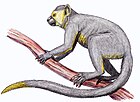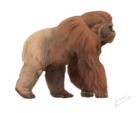오우라노피테쿠스
Ouranopithecus| 오우라노피테쿠스 시간 범위:마이오세, 4 Ma S P N | |
|---|---|
 | |
| 파리 국립자연사박물관의 Ouranopithecus mesadoniensis 두개골 | |
| 과학적 분류 | |
| 왕국: | 애니멀리아 |
| 문: | 챠다타 |
| 클래스: | 젖꼭지 |
| 주문: | 영장류 |
| 서브오더: | 하플로히니 |
| 인프라스트럭처: | 심이폼목 |
| 패밀리: | 호미나과 |
| 서브패밀리: | 인간아과 |
| 부족: | †그라코피테치니 |
| 속: | †오우라노피테쿠스 Bonis & Melentis, 1977년 |
| 종. | |
오우라노피테쿠스("Ouranopithecus")는 멸종한 유라시아의 대형 유인원으로, 마이오세 말기(9~8ina)의 두 종인 오우라노피테쿠스 마케도니엔시스(Ouranopithecus mesodoniensis)에 의해 대표된다.
첫 번째 표본 O. mesadoniensis는 1977년 [3]프랑스의 고생물학자 Louis de Bonis와 Jean Melentis에 의해 발견되었고, O. turkae는 2007년 [2]Erksin Savash Güless가 이끄는 터키 팀에 의해 발견되었다.오랫동안 그것은 그라코피테쿠스와 비슷하고 더 많은 발견들이 다르게 증명된 시바피테쿠스속의 [4]일원으로 여겨졌습니다.
설명과 체계학
O. mesadoniensis의 치아 및 얼굴 해부학적 구조에 근거해, Ouranopithecus는 실제로 드라이오피테카인 것으로 추정되고 있다.하지만, 그것은 아마도 Ponginae와 [5][6]더 가까운 관계일 것이다.일부 연구자들은 O. mesadoniensis가 인간과 다른 [7]유인원의 마지막 공통 조상이고 오스트랄로피테카인과 인간의 [8]선구자라고 생각하지만, 이것은 매우 논란이 많고 널리 받아들여지지 않는다.O. mesadoniensis가 몇몇 초기 호미닌과 파생된 특징을 공유하는 것은 사실이지만, 그들은 거의 확실히 가까운 관계가 있는 [9]종은 아니다.
1984년, 영국의 고생물학자 피터 앤드류스와 로렌스 B.마틴은 그라코피테쿠스와 오우라노피테쿠스를 동의어(같은 분류군)로 분류하고 그들을 시바피테쿠스속의 [10][11]일원으로 취급했다.그러나 비교분석 결과 동의어를 [12]뒷받침할 자료가 충분하지 않은 것으로 나타났다.
1990년대에 [14]두개골의 일부를 포함하여 더 많은 O. mesadoniensis 화석이 발견되었을[13] 때, O. mesadoniensis와 G. freybergi가 별개의 종이라는 것이 명백해졌다.1997년 호주의 고생물학자 데이비드 W. 캐머런은 그레이코피테쿠스를 분류 우선순위에 따라 유효한 속이라고 간주하고 O.마케도니엔시스를 그레이코피테쿠스 마케도니엔시스로 [15][16]명명했다.하지만, 더 나은 O. mesadoniensis 표본이 발견되었는데[17], 여기에는 터키에서 온 새로운[18] 종인 Ouranopithecus turkae가 포함되어 있어 이 속의 분리가 보증되었다.
또한, 2017년 그라코피테쿠스 표본을 꼼꼼하게 재기재함으로써 그라코피테쿠스가 [19]유인원보다는 인간과 더 관련이 있는 반면, 오우라노피테쿠스 표본은 엄격한 유인원 같은 특징을 가지고 있다는 것이 더욱 입증되었다.따라서 별도의 속은 일반적으로 계속 [20][21][22]채택되고 있다.
「 」를 참조해 주세요.
레퍼런스
- ^ de Bonis, Louis; Melentis, J (1977). "Les primates hominoides du Vallésien de Macédoine (Grèce). Étude de la machoire inférieure". Geobios. 10 (6): 849–855. doi:10.1016/s0016-6995(77)80081-8.
- ^ a b Gulec, Erksin S.; et al. (2007). "A new great ape from the lower Miocene of Turkey". Anthropological Science. 115 (2): 153–158. doi:10.1537/ase.070501.
- ^ de Bonis, Louis; Melentis, Jean (1977). "Les primates hominoides du Vallésien de Macédoine (Grèce). Étude de la machoire inférieure". Geobios. 10 (6): 849–885. doi:10.1016/S0016-6995(77)80081-8.
- ^ Martin, L.B.; Andrews, P. (1984). "The phyletic position of Graecopithecus freybergi Koenigswald". Courier Forschungsinstitut Senckenberg. 69: 25–40.
- ^ Alba, D.M.; Fortuny, J.; Moya-Sola, S.; et al. (2010). "Enamel thickness in the middle Miocene great apes Anoiapithecus, Picrolapithecus and Dryopithecus". Proceedings of the Royal Society B: Biological Sciences. 277 (1691): 2237–2245. doi:10.1098/rspb.2010.0218. PMC 2880156. PMID 20335211.
- ^ Begun, David R. (2005). "Relations among great apes and humans: New interpretations based on the fossil great ape Dryopithecus". American Journal of Physical Anthropology. 37: 11–63. doi:10.1002/ajpa.1330370604.
- ^ de Bonis, Louis; et al. (1990). "New hominoid skull material from the late Miocene of Macedonia in Northern Greece". Nature. 345 (6277): 712–4. Bibcode:1990Natur.345..712D. doi:10.1038/345712a0. PMID 2193230. S2CID 4259387.
- ^ de Bonis, Louis; Koufos, George D. (2004). "Ouranopithecus and dating the splitting of extant hominoids". Comptes Rendus Palevol. 3 (4): 257–264. doi:10.1016/j.crpv.2004.04.002.
- ^ de Bonis, Louis; et al. (1981). "Dental metric variation in early Hominids comparison between Australopithecus afarensis and Ouranopithecus macedoniensis". Comptes Rendus des Séances de l'Académie des Sciences. Serie III Sciences de la Vie. 292: 263–266.
- ^ Martin, L.B.; Andrews, P. (1984). "The phyletic position of Graecopithecus freybergi Koenigswald". Courier Forschungsinstitut Senckenberg. 69: 25–40.
- ^ Andrews, Martin L. (1984). "The phylogenetic position of Graeceopithecus freybergi Koenigswald". Courier Forschungsinstitut Senckenberg. 69: 25–40.
- ^ Koufos, George D.; de Bonis, Louis (2005). "The late Miocene Hominoids Ouranopithecus and Graeceopithecus. Implications about their relationships and taxonomy". Annales de Paléontologie. 91 (3): 227–240. doi:10.1016/j.annpal.2005.05.001.
- ^ Koufos, G. D. (1993). "Mandible of Ouranopithecus macedoniensis (Hominidae, Primates) from a new late miocene locality of Macedonia (Greece)". American Journal of Physical Anthropology. 91 (2): 225–234. doi:10.1002/ajpa.1330910208. PMID 8317563.
- ^ de Bonis, L.; Bouvrain, G.; Geraads, D.; Koufos, G. (1990). "New hominid skull material from the late Miocene of Macedonia in northern Greece". Nature. 345 (6277): 712–714. Bibcode:1990Natur.345..712D. doi:10.1038/345712a0. PMID 2193230. S2CID 4259387.
- ^ Cameron, David W. (1997). "The taxonomic status of Graecopithecus". Primates. 38 (3): 293–302. doi:10.1007/BF02381616. S2CID 28982498.
- ^ Cameron, D. W. (1997). "A revised systematic scheme for the Eurasian Miocene fossil Hominidae". Journal of Human Evolution. 33 (4): 449–477. doi:10.1006/jhev.1997.0145. PMID 9361253.
- ^ Ioannidou, Melania; Koufos, George D.; de Bonis, Louis; Harvati, Katerina (2019). "A new three-dimensional geometric morphometrics analysis of the Ouranopithecus macedoniensis cranium (Late Miocene, Central Macedonia, Greece)". American Journal of Physical Anthropology. 170 (2): 295–307. doi:10.1002/ajpa.23900. PMID 31339568. S2CID 198194561.
- ^ Güleç, Erksin Savas; Sevim, Ayla; Pehlevan, Cesur; Kaya, Ferhat (2007). "A new great ape from the late Miocene of Turkey". Anthropological Science. 115 (2): 153–158. doi:10.1537/ase.070501. ISSN 0918-7960.
- ^ Fuss, Jochen; Spassov, Nikolai; Begun, David R.; Böhme, Madelaine (2017). "Potential hominin affinities of Graecopithecus from the Late Miocene of Europe". PLOS ONE. 12 (5): e0177127. Bibcode:2017PLoSO..1277127F. doi:10.1371/journal.pone.0177127. PMC 5439669. PMID 28531170.
- ^ Andrews, Peter (2020). "Last Common Ancestor of Apes and Humans: Morphology and Environment". Folia Primatologica. 91 (2): 122–148. doi:10.1159/000501557. PMID 31533109. S2CID 202687516.
- ^ Gilbert, Christopher C.; Pugh, Kelsey D.; Fleagle, John G. (2020), Prasad, Guntupalli V.R.; Patnaik, Rajeev (eds.), "Dispersal of Miocene Hominoids (and Pliopithecoids) from Africa to Eurasia in Light of Changing Tectonics and Climate", Biological Consequences of Plate Tectonics: New Perspectives on Post-Gondwana Break-up–A Tribute to Ashok Sahni, Vertebrate Paleobiology and Paleoanthropology, Cham: Springer International Publishing, pp. 393–412, doi:10.1007/978-3-030-49753-8_17, ISBN 978-3-030-49753-8, S2CID 229622942, retrieved 2021-11-16
- ^ Almécija, Sergio; Hammond, Ashley S.; Thompson, Nathan E.; Pugh, Kelsey D.; Moyà-Solà, Salvador; Alba, David M. (2021). "Fossil apes and human evolution". Science. 372 (6542): eabb4363. doi:10.1126/science.abb4363. PMID 33958446. S2CID 233872889.
외부 링크
- 휴먼 타임라인 (인터랙티브)– Smithsonian, 국립 자연사 박물관 (2016년 8월).






